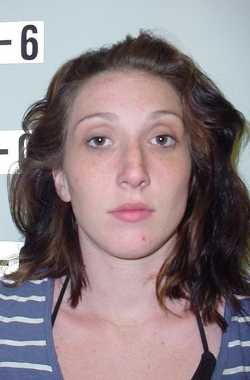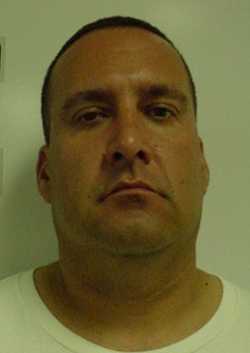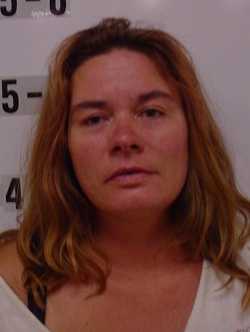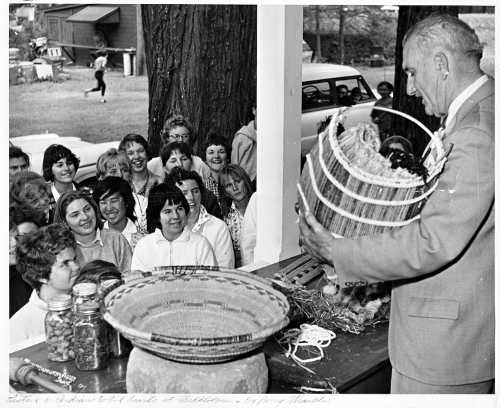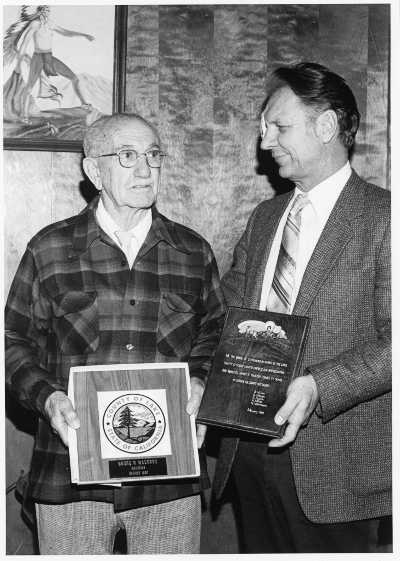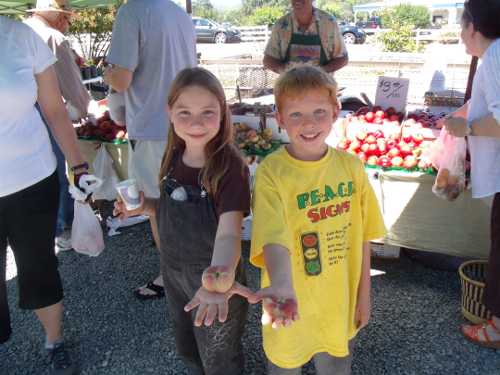
Cousins Sopheah Clark, age 9, and Jayce Curenton, age 8, proudly display donut peaches at the stone fruit stall of Reggie Dewsnup at the Lake County Farmers' Finest market at Steele Winery in Kelseyville, Calif., on Saturday, July 2, 2011. Photo by Esther Oertel.
Summer’s heart, I’m convinced, is a ripe, juicy peach.
These sumptuous beauties are piled high at farmers’ market stalls now with the California peach season in full swing from mid-June through September.
Whether round, flat, white or yellow, these fragrant, plump fruits called the name of many a farmers’ market shopper over the weekend, mine included.
I came home with a bag of carefully chosen specimens representing several peach types: sweet, mild white peaches; yellow peaches with a full-bodied, tangy taste; and gently-flavored donut peaches with their interesting, slightly squashed shape.
In my mind, peaches are as American as apple pie, synonymous with southern states such as Georgia. Their origins, however, lie at the other side of the world, in China, where peach cultivation can be traced back to the earliest days of Chinese culture.
Peaches were mentioned in Chinese writings that date back to the 10th century B.C., more than 3,000 years ago. Not surprisingly, they were a favorite of Chinese emperors and other royalty.
Pink peach blossoms graced the artwork of many an ancient Chinese painter.
A full 50 percent of the world’s peach crop is produced in modern-day China, reflecting a continuing love affair with this fruit. China is not the largest exporter of peaches, however, as most of their crop stays within their borders for local consumption. Who can blame them?
From China, they were introduced to Persia and the Mediterranean region via traders on the Silk Road. The name “peach,” in fact, derives from a Latin word meaning “Persian apple,” a misnomer arising from the belief that peaches originated in that area.
Cultivation of the peach spread from Europe to the Americas, and by the mid-1700s peaches were so plentiful here that, like me, botanists of the time thought of them as native plants.
Wild peaches, which are small, fuzzy and very tart, are found only in China and Tibet.
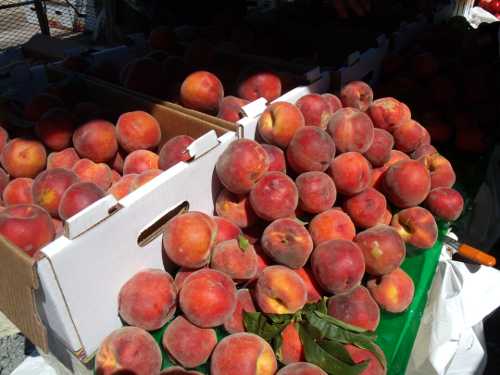
These peaches grown in Gridley, Calif. are piled at the stall of Reggie Dewsnup at the Lake County Farmers' Finest market at the Steele Winery on Saturday, July 2, 2011. Though not grown in Lake County, they're available at the market as an addition to the other types of produce grown locally. Dewsnup's peaches are also available at the Friday night farmers' market in Clearlake, Calif., sponsored by the Lake County Community Co-op. Photo by Esther Oertel.
Eating a peach is a sensuous experience, with sunset hues, sweet aromas and velvety skin engaging more than just the taste buds. If we’re lucky, a peach is juicy enough to perpetuate slurping and trickling of liquid down one’s arm.
Cultivated peaches are divided into clingstones and freestones, depending upon whether the flesh easily pulls away from the stone within. Both types can have either white or yellow flesh.
White-fleshed peaches have a lower level of acidity than their yellow-fleshed brethren, making them sweeter and milder. Yellow peaches are considered to be more flavorful, but with higher acidity, they have a bit more tang.
White-fleshed peaches tend to be favored in China, Japan and other Asian countries. Europeans and North Americans have historically chosen the yellow-fleshed type, though white peaches are gaining in popularity here.
Smooth-skinned nectarines are a cultivar group of peaches, not a cross between peaches and plums as is often erroneously believed. “Shaved peach” and “fuzzy-less peach” are a couple of the nicknames they sport. Nectarines are created via a recessive gene, sometimes springing from trees with fuzzy peaches.
Like peaches, nectarines can be clingstone or freestone, white or yellow.
The best way to store peaches is at room temperature, as refrigeration can diminish their flavor. Peaches will ripen if picked a day or two prior to full maturity; however, if picked earlier than that, chances are they won’t.
If you wish to hasten ripening, storing peaches in a paper bag for a day or so may help.
I’m currently developing a cooling soup for summer for a future culinary class made with grilled peaches, so any application utilizing the fruit in this state catches my eye.
In perusing a Jamie Oliver cookbook, I found a recipe for a salad with grilled peaches and goat cheese. He uses bresaola, a dried, cured Italian beef, in his version, but I think the sliced grilled peaches and bits of goat cheese on their own over a bed of arugula would also be a beautiful start to a meal.
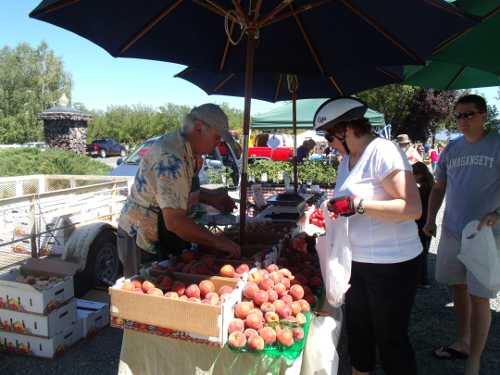
Buyers flocked to purchase peaches and other summer fruit at the Lake County Farmers' Finest market at Steele Winery in Kelseyville, Calif. on Saturday, July 2, 2011. The market runs each Saturday morning from 8:30 a.m. to noon through October, rain or shine. Photo by Esther Oertel.
The peaches may be prepared in a grill pan on the stovetop or on an outdoor barbecue. Grill until peaches are just caramelized and grill marks show, which won’t take long.
Oliver suggests throwing some herbs in the fire to give the peaches a smoky, herbal taste if using the latter method, and I like that idea. Rosemary, thyme or tarragon would be perfect for flavoring the peaches in this way.
A simple vinaigrette dressing utilizing the same herbs would make a wonderful topping for the salad. Balsamic vinegar would be a nice choice for the acid component, as would lemon juice, as both pair well with peaches, arugula and goat cheese.
Vegetarian chef and cookbook maven Deborah Madison suggests serving delicate white peaches in lemon verbena syrup, and I think the recipe sounds lovely. To make the syrup, simmer sugar in water (say, 2 cups water with about half as much sugar) with a small handful of lemon verbena leaves until the sugar has dissolved. Cover and set aside for at least half an hour for the lemon verbena to infuse the syrup. Remove leaves and add peeled, sliced white peaches. Chill and garnish with fresh lemon verbena leaves.
A spiced peach topping may be made by cooking sliced peaches with sugar, cinnamon sticks, cloves, a little balsamic vinegar and cardamom pods. (These are strong, so go lightly with them.) Simmer together until the peaches are soft, and add some candied ginger at the end.
This lovely concoction should be stored in the fridge and may be used with pork or duck, over vanilla ice cream or spread on toast at breakfast. It can easily be frozen in zipper sealed bags for use when peaches are out of season.
If some diced shallots are added during the cooking process and a stronger vinegar is used, it becomes a nice chutney.
When I was a kid growing up in the family restaurant, we served a dessert called Peach Melba, a poached half peach with vanilla ice cream and fresh raspberry sauce. I enjoyed watching it go from the kitchen to the dining room with its alcohol-soaked flaming sugar cube on top.
This dessert was created by famed chef Auguste Escoffier in 1893 to honor Australian opera singer Dame Nellie Melba. In his version, Escoffier poached peaches in wine and honey and made a raspberry sauce with sugar and fresh berries. However it’s done, raspberries and vanilla ice cream are a fantastic match for peaches.
While peaches are not the powerhouse of nutrition that some fruits are, they have a very respectable amount of vitamin A, as well as being rich in potassium and a good source of fiber.
Whether peaches are eaten at height-of-season fresh and out of hand, baked in a cobbler, pie, or any number of desserts, or even combined with Prosecco (Italian sparkling wine) for a Bellini cocktail, they’re the quintessential summer fruit. I hope you’ll savor their loveliness while they’re here.
Today’s recipe is one that furthers my fascination for grilled peaches. It comes to us from an article on grilling at the National Public Radio Web site, www.npr.org.
I especially love the cleverness of fashioning skewers from cinnamon sticks, and it’s nice to utilize outdoor cooking methods to minimize time in the kitchen during the summer heat. Bon appetit and enjoy!
Cinnamon-grilled peaches
4 large ripe freestone peaches
8 cinnamon sticks (each 3 inches long)
1 bunch fresh mint
8 tablespoons (1 stick) unsalted butter
1/2 cup firmly packed brown sugar
1/2 cup bourbon
1/2 teaspoon ground cinnamon
1 pinch salt
1 pint peach or vanilla ice cream (optional) for serving
Rinse the peaches and blot them dry with paper towels. Cut each peach in half along the crease, running your knife in a circular motion around the peach and cutting to the pit. Twist the halves in opposite directions to separate them. Using a spoon, pry out and discard the pit.
Cut each peach half in half. Using a pointed chopstick or metal skewer, make a starter hole in the center of each peach quarter, working from the pit side to the skin side. Skewer two peach quarters on each cinnamon stick, placing a mint leaf between the two quarters.
Combine the butter, brown sugar, bourbon, cinnamon, and salt in a saucepan and bring to a boil over high heat. Let the glaze boil until thick and syrupy, about five minutes.
Set up the grill for direct grilling and preheat to high.
When ready to cook, brush and oil the grill grate. Place the skewered peaches on the hot grate and grill until nicely browned, 3 to 4 minutes per side, basting with the bourbon and butter glaze. Scoop ice cream into bowls or martini glasses and arrange the peaches on top. Spoon any remaining glaze over the grilled peaches and serve at once.
Adapted from BBQ USA by Steven Raichlen. Copyright 2003 by Steven Raichlen.
Esther Oertel, the “Veggie Girl,” is a culinary coach and educator and is passionate about local produce. Oertel teaches culinary classes at Chic Le Chef in Hidden Valley Lake, Calif., and The Kitchen Gallery in Lakeport, Calif., and gives private cooking lessons. She welcomes your questions and comments; e-mail her at This email address is being protected from spambots. You need JavaScript enabled to view it..
Follow Lake County News on Twitter at http://twitter.com/LakeCoNews, on Tumblr at www.lakeconews.tumblr.com, on Facebook at http://www.facebook.com/pages/Lake-County-News/143156775604?ref=mf and on YouTube at http://www.youtube.com/user/LakeCoNews.

